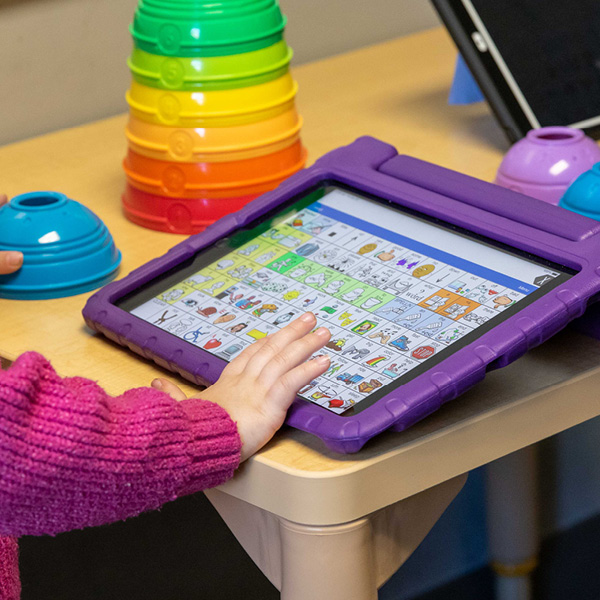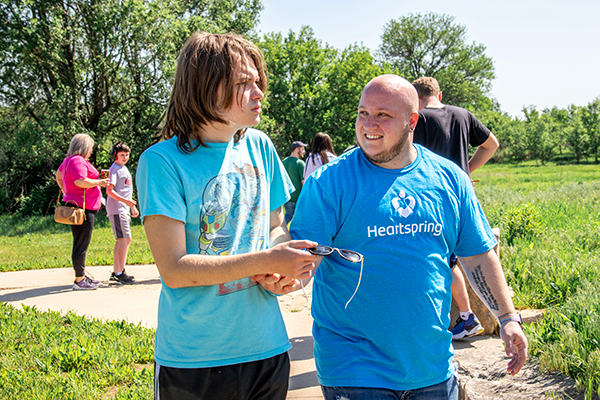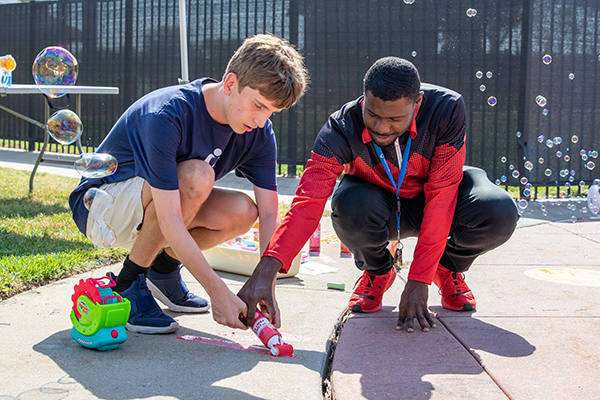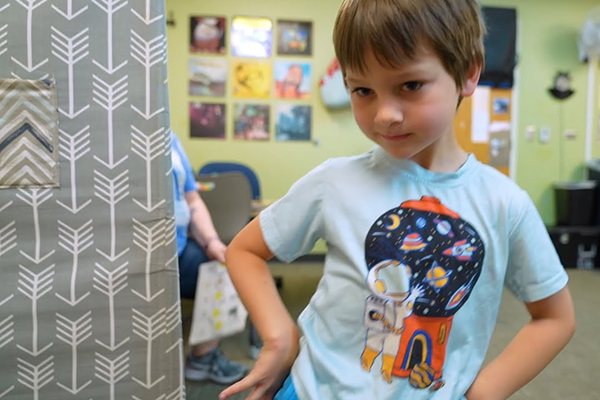6 MIN READ
How Communication and AAC Devices Work Together
Learn about augmentative and alternative communication devices and how they can help children impacted by autism.
By: Dr. Holli Steiner, Speech-Language Pathologist
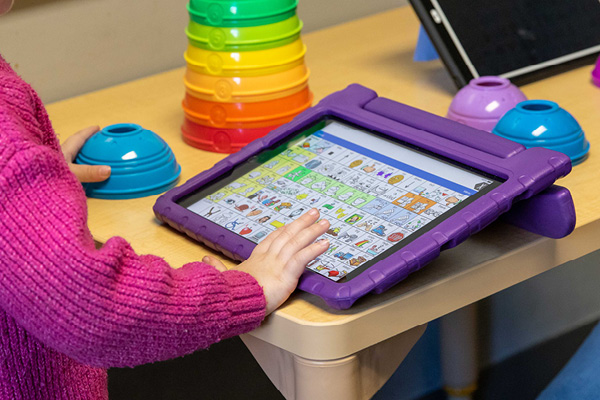
Communication, comunicación, հաղորդակցություն, Komunikacja
No matter what language one says it in: English, Spanish, Armenian, or Polish; communication allows us to express our ideas, thoughts, wants, and needs and interact with others. Typically, we speak in lots of different ways – gestures, eye contact, verbally, texting, etc. For some of the students that Heartspring serves, communication and speaking can take on a very different look.
As a Speech-Language Pathologist (SLP), I often get puzzled looks when I tell people what I do and that I work with many non-verbal students. The first thing they ask is, “How do you do that if they can’t talk?” My answer usually consists of helping my communication partner to understand that communication is so much more than just verbal speech and that the clients I serve deserve the chance to be able to communicate just as those of us who use verbal speech have that opportunity. For these clients, Augmentative and Alternative Communication (AAC) serves as that bridge by providing them with a different way to communicate.
AAC provides any person with either an alternative or augmentative way to communicate. Just as I said before, we all use other ways of communicating outside of verbal speech all of the time – and all of that is AAC! It can be something as simple as writing an email to a colleague or as complex as a full communication application downloaded onto an iPad.
Just as students practice homework at home, AAC is something that should also be practiced in order for a client to be as independent using it as possible. From my time working with clients and AAC, I have seen how important the role of training family and caregivers can be for the client’s AAC device use and success. One thing I get asked a lot is how families can better incorporate AAC into the child/client’s day. The following are my tips on how to do that:
1. Treat AAC systems as a voice.
It does not matter whether the client has a high-tech system like an iPad or a low-tech system like a picture exchange book, these communication systems should be looked at like they are voices. If you question whether to take it somewhere with you, ask yourself, “Would I take my voice with me?” If the answer is yes, then the student should also have his/her AAC system.
2. Provide opportunities to use the AAC system.
Again, it does not matter whether the system is high or low-tech, practice, practice, practice! We initially learned to communicate by practicing and interacting with others – AAC users need the same thing! Whether the system has many things loaded or just a few, I encourage communication partners to interact through book reading, conversations (greetings, answering questions, etc.), playing games, going on a walk, or any other time that a person might communicate. Remember – AAC is just another form of verbal speech.
3. Be active participants.
If you are unsure of what to ask or what things you can discuss with an AAC user, ask to borrow the system and take some time to familiarize yourself with it. If you still need more assistance, ask to schedule a training with your client’s SLP who can help teach you how it is being used at school and in speech and language sessions. If you notice that something else should be programmed into the device or that more vocabulary needs to be added, make sure to communicate that to your child’s SLP.
In my opinion, the most important part of this is to expect communication from your child. If you expect your child to communicate with his AAC system, he/she will learn that is what he/she needs to do to communicate effectively. All too often I hear that students aren’t using their systems and when questioned further, parents admit to me that they just try to figure out what their child wants instead of asking them to use the AAC system.
We all want the best for the AAC users, whether we are the parents, the teacher, the SLP, etc. but what ends up happening is that we teach them how to be passive communicators because we end up doing things for them. I saw a student with a staff member at the vending machine one day and the student was struggling to put the dollar bill into the machine. I got very excited because this could be a perfect opportunity to teach the child how to ask for help. Instead, the staff member did it for this student. I understand why he did – he wanted to be helpful! The problem with that is that we want our students to be independent communicators, so we need to start expecting and helping them to communicate more.
4. Allow the AAC user to be independent.
When training parents, staff, or other educators, I like to teach them to use the “stranger test.” All that means is that we should accept communication that would be clear to a stranger. Even if the student uses AAC, if he independently waves when someone says hi, that would pass the stranger test and be appropriate – we would not make him then go back and use his AAC system to say hi. In the latter case, we would make the student communicate the same thing twice, which can be frustrating (it would be to me as well!).
Similarly, if a student uses AAC but verbally says hello and a stranger would understand that, we would not make him use his AAC system to communicate that again; however, if he mumbled something that a stranger could not understand, it would be appropriate to direct him back to his AAC system.
Some other tips on how to allow AAC users to be independent include allowing them the chance to initiate and providing enough wait time (keep in mind that many AAC users need at least 10 seconds if not more to process questions/requests/etc.). It is also important to remember to provide questions/directives/etc. in a clear, concise manner. Students can have difficulties if we provide directions or questions that are too wordy (e.g., “Billy, uh…hey, can you get….no wait, can you hand me that picture, er….I mean task box”)
5. Have fun!
My final suggestion on how to utilize AAC in the home setting is to have fun! I always told the students I taught that if they are not having fun, then their client is definitely not having fun. Find ways to incorporate opportunities to use the AAC system in things that your family already does, such as game night, or going out to eat. It is the responsibility of all those who are invested in an AAC user to teach him/her how to use the device and what an amazing and wonderful voice it can be. Holli Steiner, PhD, CCC-SLP
Dr. Holli Steiner is a Speech-Language Pathologist (SLP) working at the Heartspring Residential School in Wichita, Kansas with more than 12 years of experience serving children with special needs, many of whom do not have verbal speech. She received her Masters and PhD degree in Communication Sciences and Disorders (CSD) from Wichita State University. Her research foci include: implementation of Augmentative and Alternative Communication (AAC) for students with special needs; investigating evaluation practices for determining students’ efficacy of using AAC and professionals’ processes for recommending AAC systems for students; establishing assessment protocols for AAC evaluations; the use of technology with aging populations, and organizational change. Holli regularly presents research exploring current AAC evaluation practices, training communication partners, and providing opportunities for pragmatic language development for students with special needs. She has presented both nationally and internationally in a variety of fields including Society for Augmentative and Alternative Communication, Applied Behavior Analysts International, International, and American Speech-Language Hearing Association.

